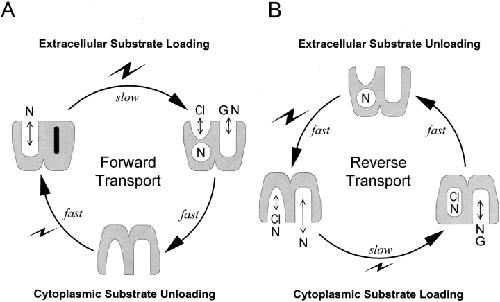XB-IMG-121026
Xenbase Image ID: 121026

|
|
Figure 1. Perspectives on the minimum reactions involved in forward and reverse GAT1 transport. (A) Forward (GABA uptake) transport mode. Starting in the upper left, one Na+ can be occluded from the extracellular side in a slow reaction that is strongly electrogenic (i.e., a large lightning bolt). Thereafter, Cl−, GABA, and a second Na+ bind and are translocated to the cytoplasmic side in a “fast” reaction that is electroneutral. Finally, transporter binding sites reorient to the outside-open position when no substrates are bound on the cytoplasmic side. This reaction is fast and weakly voltage dependent (i.e., small lightning bolt). (B) Reverse (GABA extrusion) transport mode. Starting in the lower left, Cl− and Na+ can bind from the cytoplasmic side. One Cl− and one Na+ are occluded in a slow reaction with weak voltage dependence (i.e., small lightning bolt). Thereafter, one Na+ and one GABA bind and are translocated in a fast electroneutral reaction. When empty binding sites are open to the extracellular side, one Na+ ion is still occluded in the transporter. This Na+ ion is released to the outside in a fast, strongly voltage-dependent reaction (i.e., large lightning bolt), and, in close association with this reaction, binding sites rearrange to the cytoplasmic side-open configuration. Image published in: Lu CC and Hilgemann DW (1999) © 1999 The Rockefeller University Press. Creative Commons Attribution-NonCommercial-ShareAlike license Larger Image Printer Friendly View |
